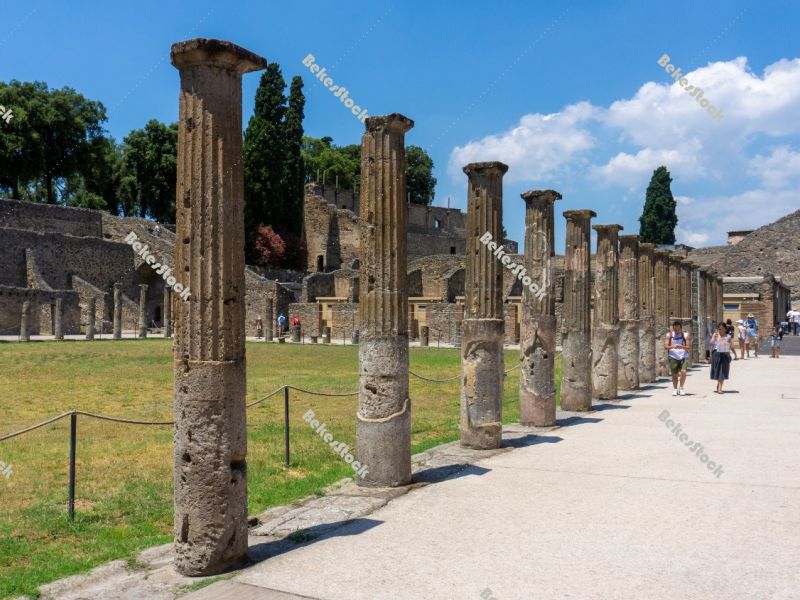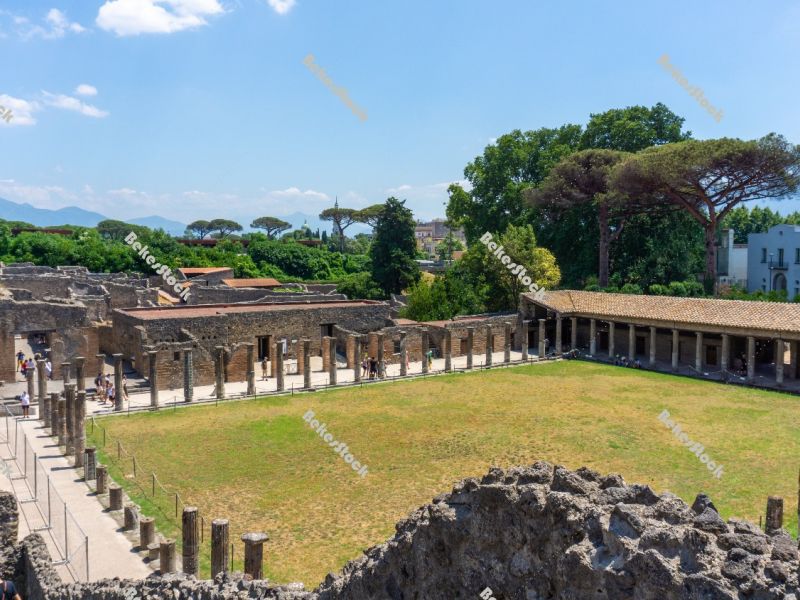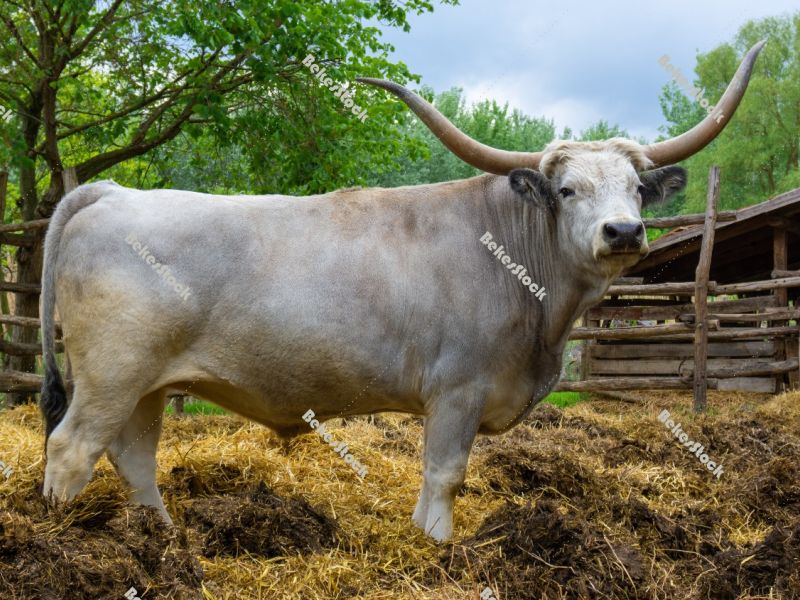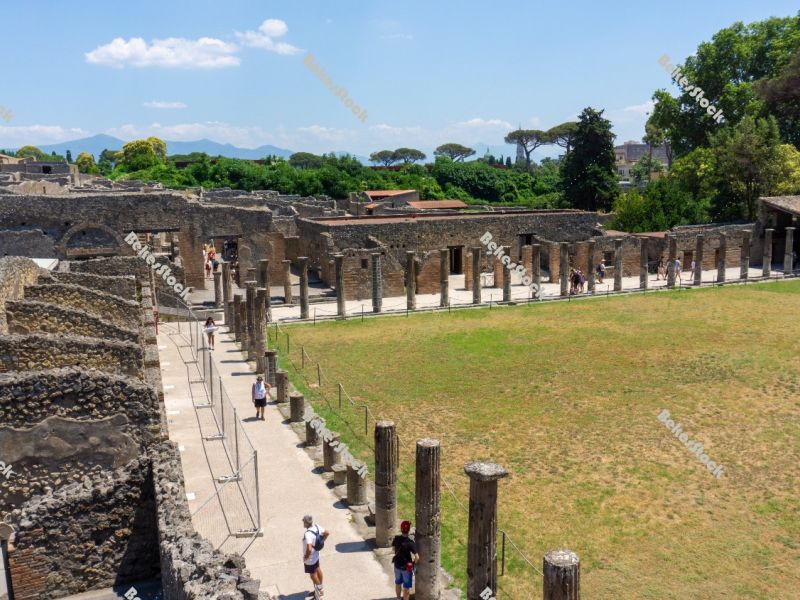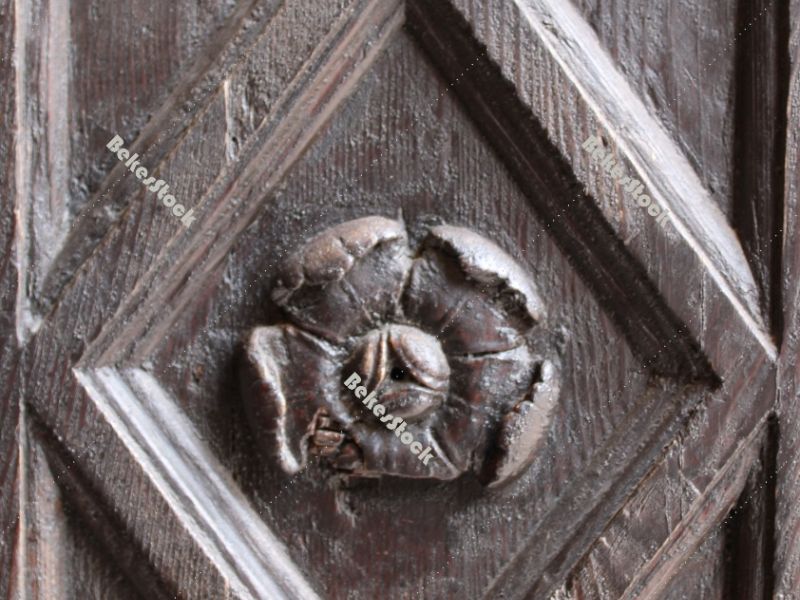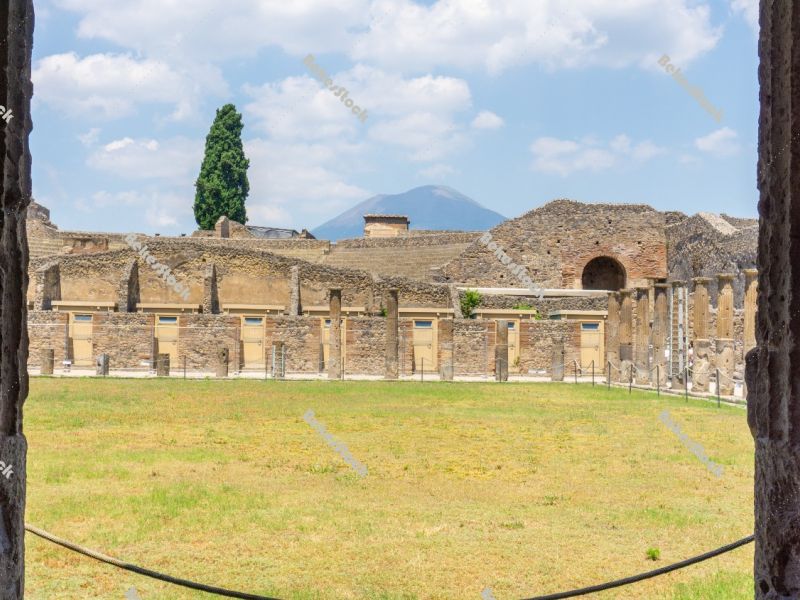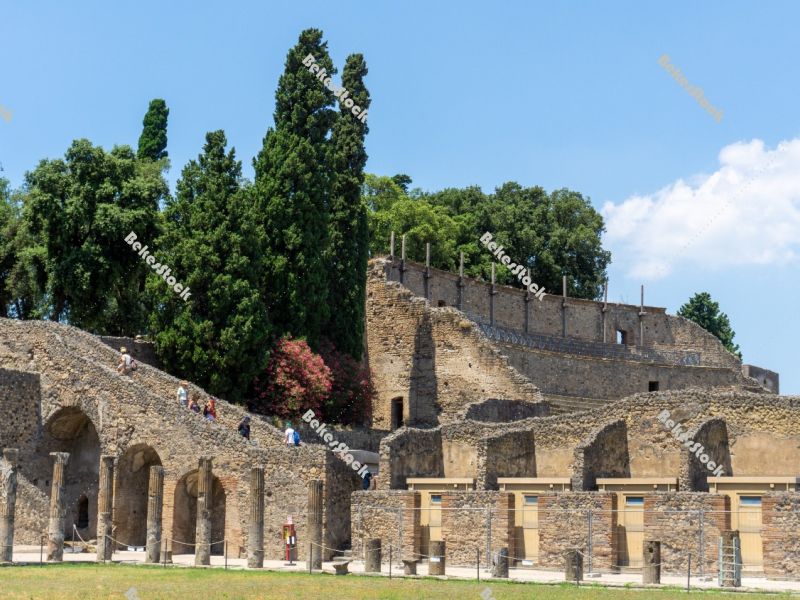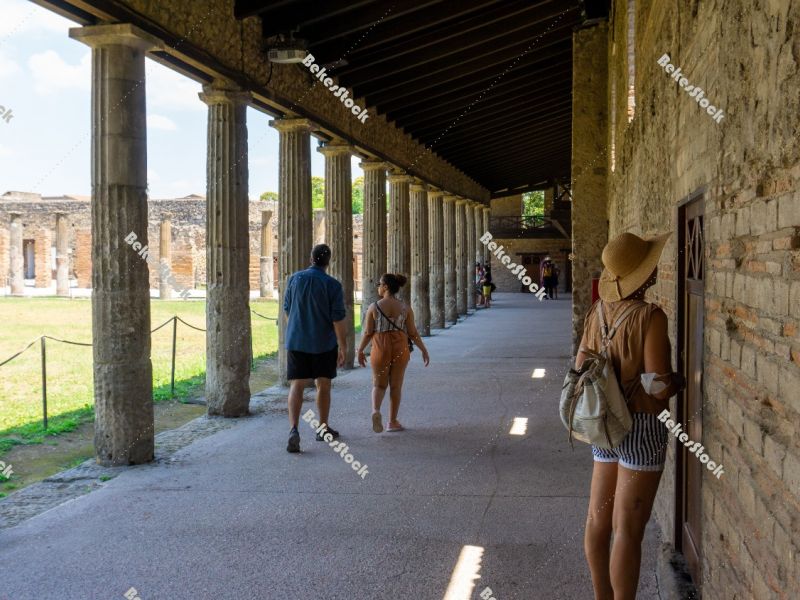Image Tags - bee
-
Cloister - QUADRIPORTICUS OF THE THEATRES OR GLADIATORS BARRACKS Cloister - QUADRIPORTICUS OF THE THEATRES OR GLADIATORS BARRACKS
Cloister - QUADRIPORTICUS OF THE THEATRES OR GLADIATORS BARRACKS in Pompeii. Behind the scene of the Large Theatre there is a large quadrangle surrounded by 74 Doric grey tuff columns of Nocera used as a foyer, an area where the spectators could stop during the intervals of the theatre shows. After the earthquake of 62 AD the building changed its function and became a barracks for gladiators, which resulted in certain parts of the building being reorganised. The most important rooms were those on the eastern side whereas the rooms upstairs may have been the apartments of the undertaker of the gladiators. Pompeii was an ancient city located in what is now the comune of Pompei near Naples in the Campania region of Italy. Pompeii, along with Herculaneum and many villas in the surrounding area, was buried under 4 to 6 m of volcanic ash and pumice in the eruption of Mount Vesuvius in AD 79 (1st century). Pompei, Naples (Napoli), Campania, Italy, July 2020. @csabaprog
ornament csabaprog decay gladiator city tourist architectural door sightseeing italian empire naples paved barrack teatro houses building vesuvius old landmark excavation vacation town eruption rome historical disaster ruins 1st house history archaeology ancient catastrophe destroyed volcano theatre doric roman journey trip vesuvio column tall ruined scenary mount died century mediterranean vesuvious architecture europe napoli romanesque famous buried unesco excursion beautiful travel remains ash overlooked stone colorful historic tourism demolished archeological italyCloister - QUADRIPORTICUS OF THE THEATRES OR GLADIATORS BARRACKS in Pompeii. Behind the scene of the Large Theatre there is a large quadrangle surrounded by 74 Doric grey tuff columns of Nocera used as a foyer, an area where the spectators could stop during the intervals of the theatre shows. After the earthquake of 62 AD the building changed its function and became a barracks for gladiators, which resulted in certain parts of the building being reorganised. The most important rooms were those on the eastern side whereas the rooms upstairs may have been the apartments of the undertaker of the gladiators. Pompeii was an ancient city located in what is now the comune of Pompei near Naples in the Campania region of Italy. Pompeii, along with Herculaneum and many villas in the surrounding area, was buried under 4 to 6 m of volcanic ash and pumice in the eruption of Mount Vesuvius in AD 79 (1st century). Pompei, Naples (Napoli), Campania, Italy, July 2020. @csabaprog
ornament csabaprog decay gladiator city tourist architectural door sightseeing italian empire naples paved barrack teatro houses building vesuvius old landmark excavation vacation town eruption rome historical disaster ruins 1st house history archaeology ancient catastrophe destroyed volcano theatre doric roman journey trip vesuvio column tall ruined scenary mount died century mediterranean vesuvious architecture europe napoli romanesque famous buried unesco excursion beautiful travel remains ash overlooked stone colorful historic tourism demolished archeological italy -
QUADRIPORTICUS OF THE THEATRES OR GLADIATORS BARRACKS in Pompeii QUADRIPORTICUS OF THE THEATRES OR GLADIATORS BARRACKS in Pompeii
QUADRIPORTICUS OF THE THEATRES OR GLADIATORS BARRACKS in Pompeii. In the background you can see mountains, trees and a blue sky. Behind the scene of the Large Theatre there is a large quadrangle surrounded by 74 Doric grey tuff columns of Nocera used as a foyer, an area where the spectators could stop during the intervals of the theatre shows. After the earthquake of 62 AD the building changed its function and became a barracks for gladiators, which resulted in certain parts of the building being reorganised. The most important rooms were those on the eastern side whereas the rooms upstairs may have been the apartments of the undertaker of the gladiators. Pompeii was an ancient city located in what is now the comune of Pompei near Naples in the Campania region of Italy. Pompeii, along with Herculaneum and many villas in the surrounding area, was buried under 4 to 6 m of volcanic ash and pumice in the eruption of Mount Vesuvius in AD 79 (1st century). Pompei, Naples (Napoli), Campania, Italy, July 2020. @csabaprog
ornament csabaprog decay gladiator city tourist panorama architectural sightseeing italian empire architecture paved barrack teatro houses building vesuvius old landmark mountains vacation town eruption rome historical disaster ruins 1st house history archaeology ancient sunny catastrophe historic volcano theatre doric trees roman journey trip vesuvio column tall ruined scenary mount died vesuvious century mediterranean excavation europe naples napoli unesco romanesque famous buried colorful excursion beautiful travel ash overlooked sky remains destroyed demolished tourism stone archeological italyQUADRIPORTICUS OF THE THEATRES OR GLADIATORS BARRACKS in Pompeii. In the background you can see mountains, trees and a blue sky. Behind the scene of the Large Theatre there is a large quadrangle surrounded by 74 Doric grey tuff columns of Nocera used as a foyer, an area where the spectators could stop during the intervals of the theatre shows. After the earthquake of 62 AD the building changed its function and became a barracks for gladiators, which resulted in certain parts of the building being reorganised. The most important rooms were those on the eastern side whereas the rooms upstairs may have been the apartments of the undertaker of the gladiators. Pompeii was an ancient city located in what is now the comune of Pompei near Naples in the Campania region of Italy. Pompeii, along with Herculaneum and many villas in the surrounding area, was buried under 4 to 6 m of volcanic ash and pumice in the eruption of Mount Vesuvius in AD 79 (1st century). Pompei, Naples (Napoli), Campania, Italy, July 2020. @csabaprog
ornament csabaprog decay gladiator city tourist panorama architectural sightseeing italian empire architecture paved barrack teatro houses building vesuvius old landmark mountains vacation town eruption rome historical disaster ruins 1st house history archaeology ancient sunny catastrophe historic volcano theatre doric trees roman journey trip vesuvio column tall ruined scenary mount died vesuvious century mediterranean excavation europe naples napoli unesco romanesque famous buried colorful excursion beautiful travel ash overlooked sky remains destroyed demolished tourism stone archeological italy -
Hungarian Grey cattle head (Magyar szürke). Also known as Hunga Hungarian Grey cattle head (Magyar szürke). Also known as Hunga
Hungarian Grey cattle head (Magyar szürke, Bos primigenius taurus Hungaricus). Also known as Hungarian Steppe Cattle. The Hungarian grey cattle is a real national symbol of Hungary, an animal that is indigenous to the country and is protected by law. Its vehemence, beauty, and an appearance hinting primordial force have made it known all over the world as one of the main characteristics of the Great Hungarian Plain. - Veszto-Magor, Bekes county, Hungary, May 2020
grass protected spring green background domestic nature cattle bekes county animal agriculture trees national tree livestock environment beef may view magyar magor detail veszto szurke cow paddock wild symbol hungarian head excrement hungary cloud dung landscape breed corral steppe gray cattle farm field békésmegye magyarországHungarian Grey cattle head (Magyar szürke, Bos primigenius taurus Hungaricus). Also known as Hungarian Steppe Cattle. The Hungarian grey cattle is a real national symbol of Hungary, an animal that is indigenous to the country and is protected by law. Its vehemence, beauty, and an appearance hinting primordial force have made it known all over the world as one of the main characteristics of the Great Hungarian Plain. - Veszto-Magor, Bekes county, Hungary, May 2020
grass protected spring green background domestic nature cattle bekes county animal agriculture trees national tree livestock environment beef may view magyar magor detail veszto szurke cow paddock wild symbol hungarian head excrement hungary cloud dung landscape breed corral steppe gray cattle farm field békésmegye magyarország -
Hungarian Grey cattle (Magyar szürke) in the corral. Also known Hungarian Grey cattle (Magyar szürke) in the corral. Also known
Hungarian Grey cattle (Magyar szürke, Bos primigenius taurus Hungaricus) in the corral. Also known as Hungarian Steppe Cattle. The Hungarian grey cattle is a real national symbol of Hungary, an animal that is indigenous to the country and is protected by law. Its vehemence, beauty, and an appearance hinting primordial force have made it known all over the world as one of the main characteristics of the Great Hungarian Plain. - Veszto-Magor, Bekes county, Hungary, May 2020
grass protected spring green background domestic dung cattle bekes county animal agriculture trees national tree livestock farm beef may view magyar magor szurke cow paddock veszto environment hungarian symbol excrement cloud steppe nature hungary breed corral landscape gray cattle wild field békésmegye magyarország hetiajanlatHungarian Grey cattle (Magyar szürke, Bos primigenius taurus Hungaricus) in the corral. Also known as Hungarian Steppe Cattle. The Hungarian grey cattle is a real national symbol of Hungary, an animal that is indigenous to the country and is protected by law. Its vehemence, beauty, and an appearance hinting primordial force have made it known all over the world as one of the main characteristics of the Great Hungarian Plain. - Veszto-Magor, Bekes county, Hungary, May 2020
grass protected spring green background domestic dung cattle bekes county animal agriculture trees national tree livestock farm beef may view magyar magor szurke cow paddock veszto environment hungarian symbol excrement cloud steppe nature hungary breed corral landscape gray cattle wild field békésmegye magyarország hetiajanlat -
QUADRIPORTICUS OF THE THEATRES OR GLADIATORS BARRACKS in Pompeii QUADRIPORTICUS OF THE THEATRES OR GLADIATORS BARRACKS in Pompeii
QUADRIPORTICUS OF THE THEATRES OR GLADIATORS BARRACKS in Pompeii. In the background you can see mountains, trees and a blue sky. Behind the scene of the Large Theatre there is a large quadrangle surrounded by 74 Doric grey tuff columns of Nocera used as a foyer, an area where the spectators could stop during the intervals of the theatre shows. After the earthquake of 62 AD the building changed its function and became a barracks for gladiators, which resulted in certain parts of the building being reorganised. The most important rooms were those on the eastern side whereas the rooms upstairs may have been the apartments of the undertaker of the gladiators. Pompeii was an ancient city located in what is now the comune of Pompei near Naples in the Campania region of Italy. Pompeii, along with Herculaneum and many villas in the surrounding area, was buried under 4 to 6 m of volcanic ash and pumice in the eruption of Mount Vesuvius in AD 79 (1st century). Pompei, Naples (Napoli), Campania, Italy, July 2020. @csabaprog
ornament csabaprog decay gladiator city tourist panorama architectural sightseeing italian empire architecture paved barrack teatro houses building vesuvius old landmark mountains vacation town eruption rome historical disaster ruins 1st house history archaeology ancient sunny catastrophe historic volcano theatre doric trees roman journey trip vesuvio column tall ruined scenary mount died vesuvious century mediterranean excavation europe naples napoli unesco romanesque famous buried colorful excursion beautiful travel ash overlooked sky remains destroyed demolished tourism stone archeological italyQUADRIPORTICUS OF THE THEATRES OR GLADIATORS BARRACKS in Pompeii. In the background you can see mountains, trees and a blue sky. Behind the scene of the Large Theatre there is a large quadrangle surrounded by 74 Doric grey tuff columns of Nocera used as a foyer, an area where the spectators could stop during the intervals of the theatre shows. After the earthquake of 62 AD the building changed its function and became a barracks for gladiators, which resulted in certain parts of the building being reorganised. The most important rooms were those on the eastern side whereas the rooms upstairs may have been the apartments of the undertaker of the gladiators. Pompeii was an ancient city located in what is now the comune of Pompei near Naples in the Campania region of Italy. Pompeii, along with Herculaneum and many villas in the surrounding area, was buried under 4 to 6 m of volcanic ash and pumice in the eruption of Mount Vesuvius in AD 79 (1st century). Pompei, Naples (Napoli), Campania, Italy, July 2020. @csabaprog
ornament csabaprog decay gladiator city tourist panorama architectural sightseeing italian empire architecture paved barrack teatro houses building vesuvius old landmark mountains vacation town eruption rome historical disaster ruins 1st house history archaeology ancient sunny catastrophe historic volcano theatre doric trees roman journey trip vesuvio column tall ruined scenary mount died vesuvious century mediterranean excavation europe naples napoli unesco romanesque famous buried colorful excursion beautiful travel ash overlooked sky remains destroyed demolished tourism stone archeological italy -
Hungarian Grey cattle head (Magyar szürke). Also known as Hunga Hungarian Grey cattle head (Magyar szürke). Also known as Hunga
Hungarian Grey cattle head (Magyar szürke, Bos primigenius taurus Hungaricus). Also known as Hungarian Steppe Cattle. The Hungarian grey cattle is a real national symbol of Hungary, an animal that is indigenous to the country and is protected by law. Its vehemence, beauty, and an appearance hinting primordial force have made it known all over the world as one of the main characteristics of the Great Hungarian Plain. - Veszto-Magor, Bekes county, Hungary, May 2020
grass protected spring green background domestic nature cattle bekes county animal agriculture trees national tree livestock environment beef may view magyar magor detail veszto szurke cow paddock wild symbol hungarian head excrement hungary cloud dung landscape breed corral steppe gray cattle farm field békésmegye magyarországHungarian Grey cattle head (Magyar szürke, Bos primigenius taurus Hungaricus). Also known as Hungarian Steppe Cattle. The Hungarian grey cattle is a real national symbol of Hungary, an animal that is indigenous to the country and is protected by law. Its vehemence, beauty, and an appearance hinting primordial force have made it known all over the world as one of the main characteristics of the Great Hungarian Plain. - Veszto-Magor, Bekes county, Hungary, May 2020
grass protected spring green background domestic nature cattle bekes county animal agriculture trees national tree livestock environment beef may view magyar magor detail veszto szurke cow paddock wild symbol hungarian head excrement hungary cloud dung landscape breed corral steppe gray cattle farm field békésmegye magyarország -
Rose decoration on the church door, Cathedral of St. Anastasia wooden door (Sveta Stošija), detail, Zadar, Croatia, December 2019 Rose decoration on the church door, Cathedral of St. Anastasia wooden door (Sveta Stošija), detail, Zadar, Croatia, December 2019
Rose decoration on the church door, Cathedral of St. Anastasia wooden door (Sveta Stošija), detail, Zadar, Croatia, December 2019. The Cathedral of St. Anastasia (Croatian: Katedrala sv. Stošije) is the Roman Catholic cathedral of Zadar, Croatia, seat of the Archdiocese of Zadar, and the largest church in all of Dalmatia (the coastal region of Croatia). The site has been submitted to UNESCO's Tentative List of World Heritage Sites
Rose decoration on the church door, Cathedral of St. Anastasia wooden door (Sveta Stošija), detail, Zadar, Croatia, December 2019. The Cathedral of St. Anastasia (Croatian: Katedrala sv. Stošije) is the Roman Catholic cathedral of Zadar, Croatia, seat of the Archdiocese of Zadar, and the largest church in all of Dalmatia (the coastal region of Croatia). The site has been submitted to UNESCO's Tentative List of World Heritage Sites
-
The view of Vesuvius from the Gladiators' Barracks. Pompei, Camp The view of Vesuvius from the Gladiators' Barracks. Pompei, Camp
The view of Vesuvius from the Gladiators' Barracks (QUADRIPORTICUS OF THE THEATRES). Behind the scene of the Large Theatre there is a large quadrangle surrounded by 74 Doric grey tuff columns of Nocera used as a foyer, an area where the spectators could stop during the intervals of the theatre shows. After the earthquake of 62 AD the building changed its function and became a barracks for gladiators, which resulted in certain parts of the building being reorganised. The most important rooms were those on the eastern side whereas the rooms upstairs may have been the apartments of the undertaker of the gladiators. Pompeii was an ancient city located in what is now the comune of Pompei near Naples in the Campania region of Italy. Pompeii, along with Herculaneum and many villas in the surrounding area, was buried under 4 to 6 m of volcanic ash and pumice in the eruption of Mount Vesuvius in AD 79 (1st century). Pompei, Naples (Napoli), Campania, Italy, July 2020. @csabaprog
ornament csabaprog decay gladiator city tourist architectural door sightseeing italian empire naples paved barrack teatro houses building vesuvius old landmark excavation vacation town eruption rome historical disaster ruins 1st house history archaeology ancient catastrophe destroyed volcano theatre doric roman journey trip vesuvio column tall ruined scenary mount died century mediterranean vesuvious architecture europe napoli romanesque famous buried unesco excursion beautiful travel remains ash overlooked stone colorful historic tourism demolished archeological italyThe view of Vesuvius from the Gladiators' Barracks (QUADRIPORTICUS OF THE THEATRES). Behind the scene of the Large Theatre there is a large quadrangle surrounded by 74 Doric grey tuff columns of Nocera used as a foyer, an area where the spectators could stop during the intervals of the theatre shows. After the earthquake of 62 AD the building changed its function and became a barracks for gladiators, which resulted in certain parts of the building being reorganised. The most important rooms were those on the eastern side whereas the rooms upstairs may have been the apartments of the undertaker of the gladiators. Pompeii was an ancient city located in what is now the comune of Pompei near Naples in the Campania region of Italy. Pompeii, along with Herculaneum and many villas in the surrounding area, was buried under 4 to 6 m of volcanic ash and pumice in the eruption of Mount Vesuvius in AD 79 (1st century). Pompei, Naples (Napoli), Campania, Italy, July 2020. @csabaprog
ornament csabaprog decay gladiator city tourist architectural door sightseeing italian empire naples paved barrack teatro houses building vesuvius old landmark excavation vacation town eruption rome historical disaster ruins 1st house history archaeology ancient catastrophe destroyed volcano theatre doric roman journey trip vesuvio column tall ruined scenary mount died century mediterranean vesuvious architecture europe napoli romanesque famous buried unesco excursion beautiful travel remains ash overlooked stone colorful historic tourism demolished archeological italy -
QUADRIPORTICUS OF THE THEATRES OR GLADIATORS BARRACKS in Pompeii QUADRIPORTICUS OF THE THEATRES OR GLADIATORS BARRACKS in Pompeii
QUADRIPORTICUS OF THE THEATRES OR GLADIATORS BARRACKS in Pompeii. Behind the scene of the Large Theatre there is a large quadrangle surrounded by 74 Doric grey tuff columns of Nocera used as a foyer, an area where the spectators could stop during the intervals of the theatre shows. After the earthquake of 62 AD the building changed its function and became a barracks for gladiators, which resulted in certain parts of the building being reorganised. The most important rooms were those on the eastern side whereas the rooms upstairs may have been the apartments of the undertaker of the gladiators. Pompeii was an ancient city located in what is now the comune of Pompei near Naples in the Campania region of Italy. Pompeii, along with Herculaneum and many villas in the surrounding area, was buried under 4 to 6 m of volcanic ash and pumice in the eruption of Mount Vesuvius in AD 79 (1st century). Pompei, Naples (Napoli), Campania, Italy, July 2020. @csabaprog
ornament csabaprog decay gladiator city tourist architectural door sightseeing italian empire naples paved barrack teatro houses building vesuvius old landmark excavation vacation town eruption rome historical disaster ruins 1st house history archaeology ancient catastrophe destroyed volcano theatre doric roman journey trip vesuvio column tall ruined scenary mount died century mediterranean vesuvious architecture europe napoli romanesque famous buried unesco excursion beautiful travel remains ash overlooked stone colorful historic tourism demolished archeological italyQUADRIPORTICUS OF THE THEATRES OR GLADIATORS BARRACKS in Pompeii. Behind the scene of the Large Theatre there is a large quadrangle surrounded by 74 Doric grey tuff columns of Nocera used as a foyer, an area where the spectators could stop during the intervals of the theatre shows. After the earthquake of 62 AD the building changed its function and became a barracks for gladiators, which resulted in certain parts of the building being reorganised. The most important rooms were those on the eastern side whereas the rooms upstairs may have been the apartments of the undertaker of the gladiators. Pompeii was an ancient city located in what is now the comune of Pompei near Naples in the Campania region of Italy. Pompeii, along with Herculaneum and many villas in the surrounding area, was buried under 4 to 6 m of volcanic ash and pumice in the eruption of Mount Vesuvius in AD 79 (1st century). Pompei, Naples (Napoli), Campania, Italy, July 2020. @csabaprog
ornament csabaprog decay gladiator city tourist architectural door sightseeing italian empire naples paved barrack teatro houses building vesuvius old landmark excavation vacation town eruption rome historical disaster ruins 1st house history archaeology ancient catastrophe destroyed volcano theatre doric roman journey trip vesuvio column tall ruined scenary mount died century mediterranean vesuvious architecture europe napoli romanesque famous buried unesco excursion beautiful travel remains ash overlooked stone colorful historic tourism demolished archeological italy -
Interior of the Cathedral of St. Anastasia ('Sveta Stošija'), Zadar, Croatia, December 2019 Interior of the Cathedral of St. Anastasia ('Sveta Stošija'), Zadar, Croatia, December 2019
Interior of the Cathedral of St. Anastasia ('Sveta Stošija'), Zadar, Croatia, December 2019. The Cathedral of St. Anastasia (Croatian: Katedrala sv. Stošije) is the Roman Catholic cathedral of Zadar, Croatia, seat of the Archdiocese of Zadar, and the largest church in all of Dalmatia (the coastal region of Croatia). The site has been submitted to UNESCO's Tentative List of World Heritage Sites
Interior of the Cathedral of St. Anastasia ('Sveta Stošija'), Zadar, Croatia, December 2019. The Cathedral of St. Anastasia (Croatian: Katedrala sv. Stošije) is the Roman Catholic cathedral of Zadar, Croatia, seat of the Archdiocese of Zadar, and the largest church in all of Dalmatia (the coastal region of Croatia). The site has been submitted to UNESCO's Tentative List of World Heritage Sites
-
Closeup yellow lilies - spring in Hungary Closeup yellow lilies - spring in Hungary
Detailed view of yellow lilies. A bee crawls in the flower. Background with green leaves. - Telekgerendas, Bekes county, Hungary, May 2020
hungary lily spring color blossom beauty orange yellow lilies macro flora bee outdoors petal may bekes organic lilly botanic wasp closeup floral selective focus yellow bloom detailed lilies garden leaves green hungarian flower beautiful open county gardens decoration nature park fresh bekes county telekgerendas detail békésmegye magyarországDetailed view of yellow lilies. A bee crawls in the flower. Background with green leaves. - Telekgerendas, Bekes county, Hungary, May 2020
hungary lily spring color blossom beauty orange yellow lilies macro flora bee outdoors petal may bekes organic lilly botanic wasp closeup floral selective focus yellow bloom detailed lilies garden leaves green hungarian flower beautiful open county gardens decoration nature park fresh bekes county telekgerendas detail békésmegye magyarország -
Grilled chicken with roasted vegetables. Koper (`Capodistria`), Grilled chicken with roasted vegetables. Koper (`Capodistria`),
Grilled chicken with fried vegetables on the table of the Savor Restaurant & Wine Bar. City beach (`Mestna plaža`), Koper (`Capodistria`), Slovenia, June 2020. @csabaprog
spice glass sunny summer adriatic bay zucchini city table 2020 coast mestna plaza sea chicken slovenian capodistria beach attraction touristic europe istria carrot coke trip balkan wine csabaprog june bar vegetable adria cola fork fried beetroot marina restaurant colorful ashtray mediterranean outdoor grilled plate capital food koper exterior slovenia vegetables town vacation travel savor tourists tourist mayonnaise knife seafront tourism potato onionGrilled chicken with fried vegetables on the table of the Savor Restaurant & Wine Bar. City beach (`Mestna plaža`), Koper (`Capodistria`), Slovenia, June 2020. @csabaprog
spice glass sunny summer adriatic bay zucchini city table 2020 coast mestna plaza sea chicken slovenian capodistria beach attraction touristic europe istria carrot coke trip balkan wine csabaprog june bar vegetable adria cola fork fried beetroot marina restaurant colorful ashtray mediterranean outdoor grilled plate capital food koper exterior slovenia vegetables town vacation travel savor tourists tourist mayonnaise knife seafront tourism potato onion -
Cloister - QUADRIPORTICUS OF THE THEATRES OR GLADIATORS BARRACKS Cloister - QUADRIPORTICUS OF THE THEATRES OR GLADIATORS BARRACKS
Cloister - QUADRIPORTICUS OF THE THEATRES OR GLADIATORS BARRACKS in Pompeii. A lady looks through a closed door. Behind the scene of the Large Theatre there is a large quadrangle surrounded by 74 Doric grey tuff columns of Nocera used as a foyer, an area where the spectators could stop during the intervals of the theatre shows. After the earthquake of 62 AD the building changed its function and became a barracks for gladiators, which resulted in certain parts of the building being reorganised. The most important rooms were those on the eastern side whereas the rooms upstairs may have been the apartments of the undertaker of the gladiators. Pompeii was an ancient city located in what is now the comune of Pompei near Naples in the Campania region of Italy. Pompeii, along with Herculaneum and many villas in the surrounding area, was buried under 4 to 6 m of volcanic ash and pumice in the eruption of Mount Vesuvius in AD 79 (1st century). Pompei, Naples (Napoli), Campania, Italy, July 2020. @csabaprog
ornament csabaprog decay gladiator city tourist lady architectural door sightseeing italian empire naples paved barrack teatro houses building vesuvius old landmark excavation vacation town eruption rome historical disaster ruins 1st house history archaeology ancient catastrophe historic volcano theatre doric roman looks journey trip vesuvio column tall ruined scenary mount died century mediterranean vesuvious architecture europe napoli unesco romanesque famous buried colorful excursion beautiful travel ash overlooked stone destroyed remains demolished tourism woman archeological italyCloister - QUADRIPORTICUS OF THE THEATRES OR GLADIATORS BARRACKS in Pompeii. A lady looks through a closed door. Behind the scene of the Large Theatre there is a large quadrangle surrounded by 74 Doric grey tuff columns of Nocera used as a foyer, an area where the spectators could stop during the intervals of the theatre shows. After the earthquake of 62 AD the building changed its function and became a barracks for gladiators, which resulted in certain parts of the building being reorganised. The most important rooms were those on the eastern side whereas the rooms upstairs may have been the apartments of the undertaker of the gladiators. Pompeii was an ancient city located in what is now the comune of Pompei near Naples in the Campania region of Italy. Pompeii, along with Herculaneum and many villas in the surrounding area, was buried under 4 to 6 m of volcanic ash and pumice in the eruption of Mount Vesuvius in AD 79 (1st century). Pompei, Naples (Napoli), Campania, Italy, July 2020. @csabaprog
ornament csabaprog decay gladiator city tourist lady architectural door sightseeing italian empire naples paved barrack teatro houses building vesuvius old landmark excavation vacation town eruption rome historical disaster ruins 1st house history archaeology ancient catastrophe historic volcano theatre doric roman looks journey trip vesuvio column tall ruined scenary mount died century mediterranean vesuvious architecture europe napoli unesco romanesque famous buried colorful excursion beautiful travel ash overlooked stone destroyed remains demolished tourism woman archeological italy

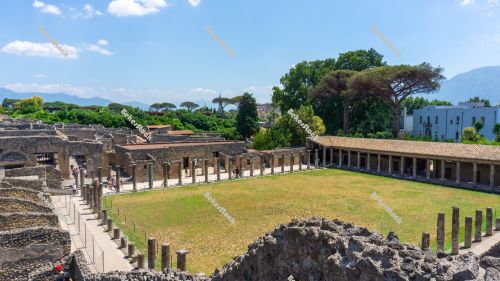

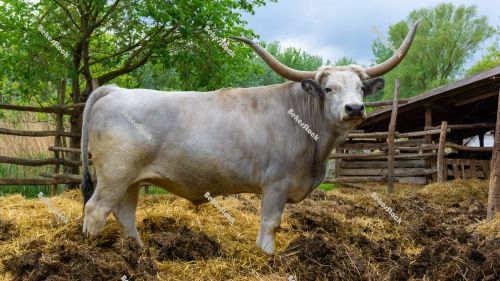
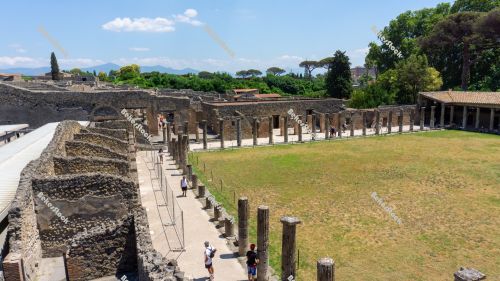

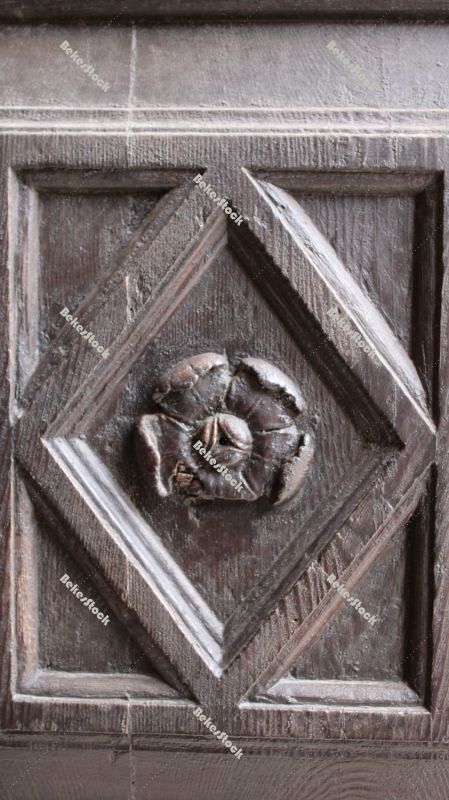
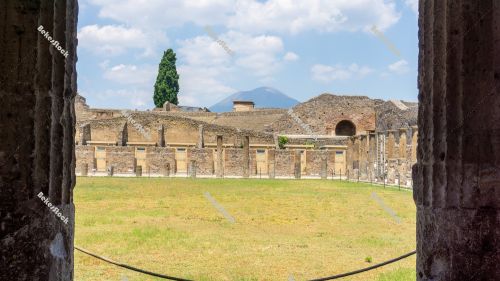
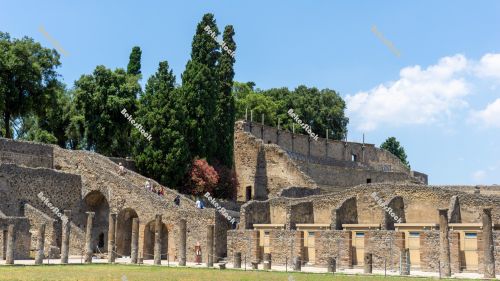
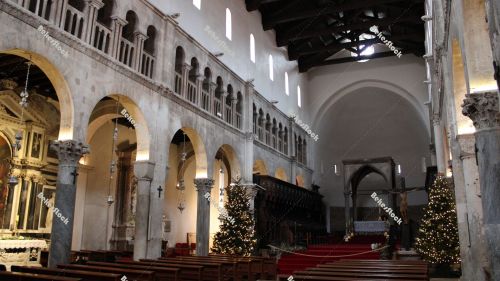


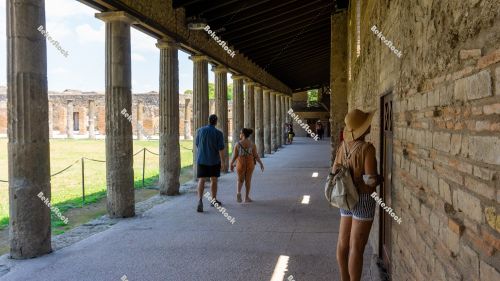
-
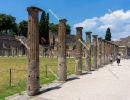 Cloister - QUADRIPORTICUS OF THE THEATRES OR GLADIATORS BARRACKS
Cloister - QUADRIPORTICUS OF THE THEATRES OR GLADIATORS BARRACKS -
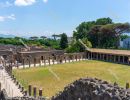 QUADRIPORTICUS OF THE THEATRES OR GLADIATORS BARRACKS in Pompeii
QUADRIPORTICUS OF THE THEATRES OR GLADIATORS BARRACKS in Pompeii -
 Hungarian Grey cattle head (Magyar szürke). Also known as Hunga
Hungarian Grey cattle head (Magyar szürke). Also known as Hunga -
 Hungarian Grey cattle (Magyar szürke) in the corral. Also known
Hungarian Grey cattle (Magyar szürke) in the corral. Also known -
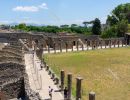 QUADRIPORTICUS OF THE THEATRES OR GLADIATORS BARRACKS in Pompeii
QUADRIPORTICUS OF THE THEATRES OR GLADIATORS BARRACKS in Pompeii -
 Hungarian Grey cattle head (Magyar szürke). Also known as Hunga
Hungarian Grey cattle head (Magyar szürke). Also known as Hunga -
 Rose decoration on the church door, Cathedral of St. Anastasia wooden door (Sveta Stošija), detail, Zadar, Croatia, December 2019
Rose decoration on the church door, Cathedral of St. Anastasia wooden door (Sveta Stošija), detail, Zadar, Croatia, December 2019 -
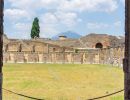 The view of Vesuvius from the Gladiators' Barracks. Pompei, Camp
The view of Vesuvius from the Gladiators' Barracks. Pompei, Camp -
 QUADRIPORTICUS OF THE THEATRES OR GLADIATORS BARRACKS in Pompeii
QUADRIPORTICUS OF THE THEATRES OR GLADIATORS BARRACKS in Pompeii -
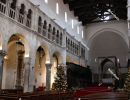 Interior of the Cathedral of St. Anastasia ('Sveta Stošija'), Zadar, Croatia, December 2019
Interior of the Cathedral of St. Anastasia ('Sveta Stošija'), Zadar, Croatia, December 2019 -
 Closeup yellow lilies - spring in Hungary
Closeup yellow lilies - spring in Hungary -
 Grilled chicken with roasted vegetables. Koper (`Capodistria`),
Grilled chicken with roasted vegetables. Koper (`Capodistria`), -
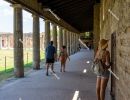 Cloister - QUADRIPORTICUS OF THE THEATRES OR GLADIATORS BARRACKS
Cloister - QUADRIPORTICUS OF THE THEATRES OR GLADIATORS BARRACKS

